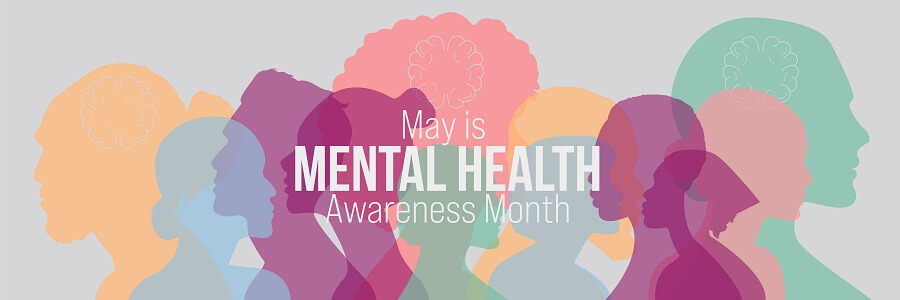An SMB’s Guide to Mental Health Awareness Month in the Workplace

Quick look: Millions of Americans are impacted by mental illness every year, making Mental Health Awareness Month an ideal time for employers to raise awareness and improve their approach to mental well-being in the workplace. Discover the history of Mental Health Awareness Month and learn how to create a happier, healthier business through the right employee benefits, company culture adjustments, and a partnership with a professional employer organization (PEO).
In the United States, more than 1 in 4 adults live with a mental illness. And because May is Mental Health Awareness Month, it’s an opportune time for employers to foster a culture of mental wellness and promote knowledge of and break the stigma surrounding mental health.
Keep reading to explore the history of Mental Health Awareness Month, tips to promote mental wellness in your organization, and how partnering with a professional employer organization (PEO) can provide your business with comprehensive and cost-effective mental wellness benefits and programs.
About Mental Health Awareness Month
Mental Health Awareness Month was established in 1949 by Mental Health America (MHA), the nation’s leading community-based nonprofit dedicated to addressing the needs of those living with mental illness. In the wake of the Great Depression and two world wars, people were finally beginning to focus on what used to be called “mental hygiene,” and legislation and healthcare facilities began to advocate for mental wellness.
In 2024, the Mental Health Awareness Month theme is “Where to Start: Mental Health in a Changing World.” Many people experience ever-changing personal, work, and societal factors, leaving some to wonder “where to start” when overwhelmed by the various challenges. Thus, this year’s Mental Health Awareness Month theme aims to equip individuals, employers, schools, and communities with tools to prioritize mental health in today’s busy world.
Additionally, during Mental Health Awareness Month, MHA encourages people to wear green, the official color of mental health awareness. Green symbolizes renewal, hope, and vitality, and wearing it demonstrates one’s commitment to mental wellness. MHA also invites buildings and structures across the country to light up green to spread awareness.
Employers interested in participating in Mental Health Awareness Month can click here to access various MHA resources, from email templates to event-planning tips.
The cost of poor mental health in the workplace
Employees’ mental well-being has a direct impact on the health of the overall organization. Employees with self-reported fair or poor mental health have approximately 12 unplanned absences per year (compared to 2.5 for all other workers), amounting to roughly $48 billion in lost productivity. And it’s not a small amount of staff feeling burdened: Gallup’s State of the Global Workplace Report 2023 found that employee stress continues to reach record levels, with 44% of employees worldwide claiming they experienced a lot of stress the previous day.
Poor mental health and stress can negatively impact your employees in numerous ways:
- Decreased job performance
- Lack of workplace engagement
- Increased absenteeism
- Reduced physical and daily functioning capabilities
Mental wellness struggles can also impact your business’s bottom line. Consider these statistics:
- Lost productivity due to anxiety and depression is estimated to cost the global economy $1 trillion annually.
- Adults with private insurance who are treated for anxiety or depression spend almost twice as much on annual out-of-pocket costs compared to those not treated for a mental health diagnosis, which can raise overall healthcare costs.
- One in four U.S. adults say they’ve quit a job due to their mental health, which leaves employers with the expensive task of replacing them.
Conversely, data also shows that for every $1 spent on treating mental health, there is a return of $4 in improved health and efficiency, demonstrating that happy employees are productive employees. Additionally, fostering a work environment that prioritizes well-being is associated with improved employee engagement, reduced stress levels, decreased healthcare costs, more successful talent acquisition, and more.
What can employers do to take action?
In addition to celebrating Mental Health Awareness Month in the workplace, employers can prioritize their staff’s mental well-being throughout the year by offering comprehensive employee benefits and cultivating a culture that emphasizes work-life balance and breaks down stigmas.
HSA Bank’s 2023 Health & Wealth Index reports that the percentage of employers offering mental health care coverage has increased to 27%, up from 23% in 2022. This trend is likely to continue, and many employers are turning to a PEO for guidance on improving access to care. Working with a PEO opens the door to easy and cost-effective voluntary and employee benefit services that attract candidates and keep current employees happy. In fact, 92% of workers state that it is very or somewhat important to work at an organization that provides mental health support.
With that in mind, here are several ways small businesses can support their workforce’s mental well-being, including key mental health benefits today’s employees expect.
Employee Assistance Program (EAP)
An employee assistance program, or EAP, is “a work-based intervention program designed to assist employees in resolving personal problems that may be adversely affecting the employee’s performance.”
Employees can leverage an EAP to confidentially discuss and address mental health issues like depression, grief, loss, family, marital, and other relationship issues, or stress and anxiety. An EAP also offers a variety of other services, including addressing financial and legal concerns, identity theft and fraud resolution, and caregiving resources.
Telehealth
The use of telehealth has rapidly grown since the COVID-19 pandemic, and many providers have expanded offerings to accommodate more employees wishing to seek non-emergency care from the comfort of their homes. A recent study reported that 76% of consumers have used virtual healthcare at least once, 83% of whom have used the service within the last 12 months.
Telehealth services can make virtual therapy sessions possible. Business leaders can consider adding telehealth services to their benefit offerings to give workers quick, convenient access to mental health providers. And since many telehealth services are now included in standard plans, the convenience of virtual health usually comes at minimal or no extra cost for employers.
In-office wellness spaces
Whether workplace stresses or other factors are involved, employees’ personal needs can’t always wait until the end of the workday. A corporate wellness space—a specialized room for mindfulness, meditation, and other spiritual exercises—can offer a private area for staff to refresh, recharge, and dive back into their work with their best foot forward.
Adding a dedicated wellness room to your office demonstrates that even during a challenging day, employees can find a private space to work through their needs. Consider adding a comfortable couch, lounger, or chairs, as well as gentle lighting with dimmer switches (migraines and light sensitivity-causing headaches are a common use of wellness rooms).
A healthy work-life balance
One of job seekers’ most sought-after perks is a flexible work schedule. For many, hybrid working is here to stay, and policies that support mental health awareness remain important. Creating a work environment that encourages people to set reasonable work hours, prioritizes mental and physical health, and gives employees options over where and how they work helps boost workplace morale and can be an extremely valuable recruiting tool.
Leadership involvement and understanding
Company leadership should show compassion and knowledge of the stressors that lead to mental illness in the workplace and let employees know that asking for help is not a sign of weakness. If comfortable, business leaders can also share their own mental health stories.
Special events
In addition to adding mental health coverage and programs into an employee benefit plan, employers can also consider initiatives like stress awareness days, free mental health screenings, fitness challenges, and educational lunch and learns. These activities can go a long way toward improving workplace culture.
Required mental health offerings
It’s important to note that some benefits and accommodations are legally mandated. These requirements include:
- The Mental Health Parity and Addiction Equity Act (MHPAEA): Requires employers with 50 or more employees to provide coverage for mental health, behavioral health, and substance-use disorders equal to physical care coverage.
- Adhering to the Americans with Disabilities Act: Limits an employer’s ability to ask workers questions about disabilities, including mental health conditions.
- Complying with the Family and Medical Leave Act (FMLA): Mandates that employers provide 12 weeks of job-protected leave to eligible employees, including in mental health-related instances. (Please be aware that various states and local jurisdictions have their own rules concerning paid and unpaid family leave, as well as paid and unpaid sick and safe leave. Please refer to the specific laws relevant to your location to ensure you have the correct information.)
- Providing reasonable accommodation and discrimination protections to staff with mental health conditions: Employees with mental health conditions may be protected against discrimination and harassment and have the right to workplace confidentiality and reasonable accommodations that enable them to execute and keep their jobs.
PEO: A team of helping hands during your business’s mental wellness journey
Employers play a pivotal role in supporting employee mental health and safety—but they don’t have to do it alone. The human resources experts at a PEO can offer guidance and help small businesses revise existing healthcare plans to include mental wellness benefits, proactively address mental health with resources and events, maintain compliance with applicable laws, and create a culture of transparency where employees can openly discuss their well-being.
Investing in your people is investing in your business, too. Recruiting and retaining top talent, increased productivity, and higher morale—all associated with a robust mental health offering—can boost your bottom line and help build a more resilient organization.
It’s never too late to create a forum for discussion and proactively transform your workplace wellness programs. Contact us today and learn how ExtensisHR can help ramp up your mental health efforts.
The content of this article and other material contained on the ExtensisHR website are for informational purposes only and is not intended to be a substitute for medical or professional advice. If you, or someone you know is in crisis call 1-800-273-TALK (8255) to speak with a skilled, trained counselor at a crisis center in your area at any time (National Suicide Prevention Lifeline).



